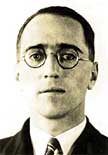
Born in London in 1903, Alan Dower Blumlein lived a short life, but during those 38 years, he changed the way that an entire world listens. After receiving his B.S. degree in 1923, he worked at Standard Telephones and Cables, but his main contributions to audio came after he joined the Columbia Graphophone Company in 1929. His early innovations included a moving-coil wax cutter head for gramophone lathes and a moving-coil microphone. Throughout the audio world, he is best known for his 1931 patent, simply entitled “Improvements In and Relating to Sound-Transmissions, Sound-Recording and Sound-Reproducing Systems.”
In this patent (British #394,325), Blumlein examines the physiology of the human binaural hearing process and the spatial illusion produced by “two or more loudspeakers”; describes the use of multiple microphones—including the crossed figure-8 (now known as the Blumlein technique) and Mid-Side stereo-miking methods; details a dual 45/45-degree phono cutter head for producing stereo record masters; and proposes a means of transmitting stereo radio. Many of the concepts in this patent did not reach fruition for decades to come, but all have had an enormous impact on the evolution of audio. Around the time of the patent, Columbia Graphophone Company merged with Gramophone Company (HMV), forming Electric and Musical Industries (eventually, this became EMI) and Blumlein stayed on, researching vacuum cathode ray tubes used in the Iconoscope for early TV cameras.
Blumlein was granted some 128 patents on subjects such as antennas and radar systems. In fact, it was such research that led to his death in 1942, when he and 10 others were killed during a secret flight testing a radar system. One can only guess at what wonders Blumlein could have devised had he lived another 38 years.







